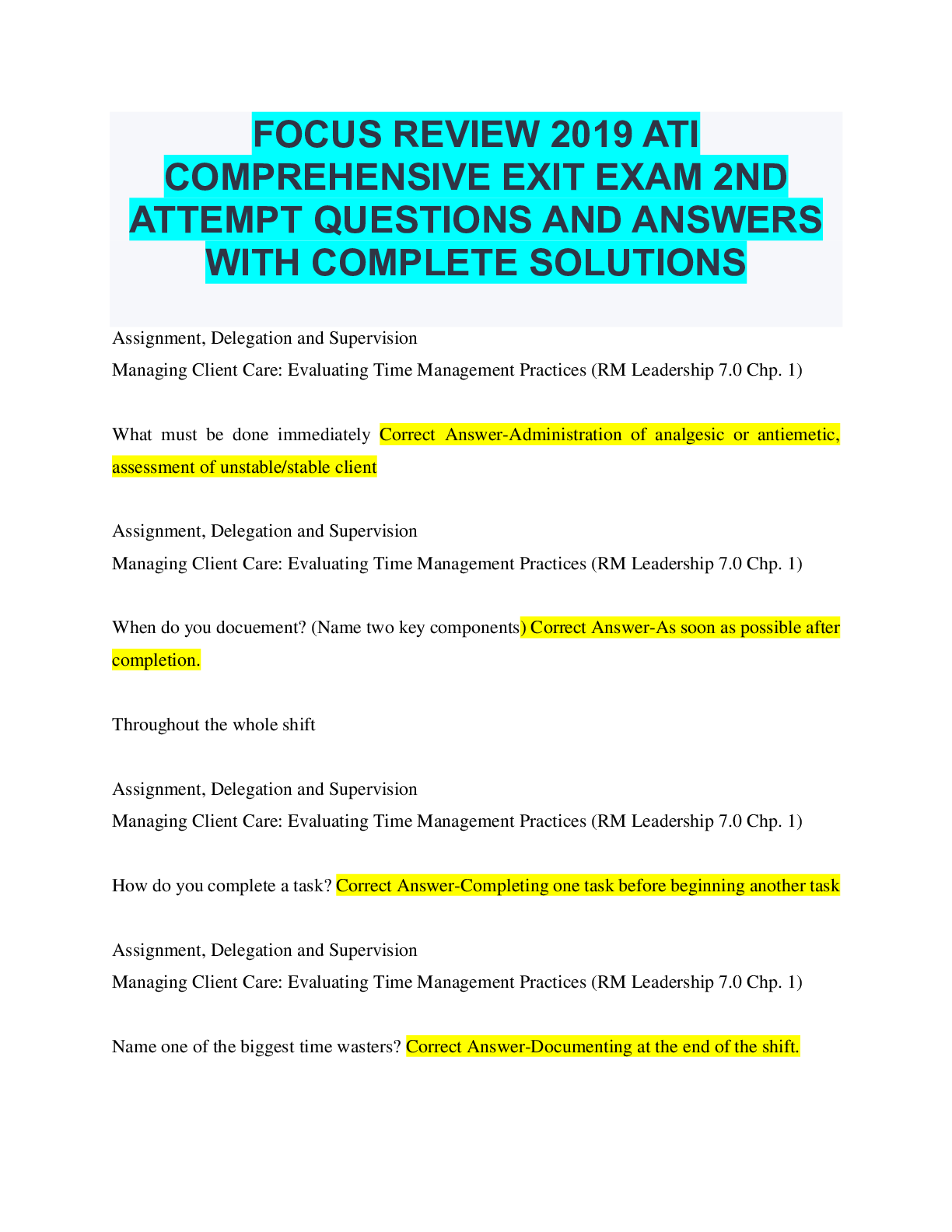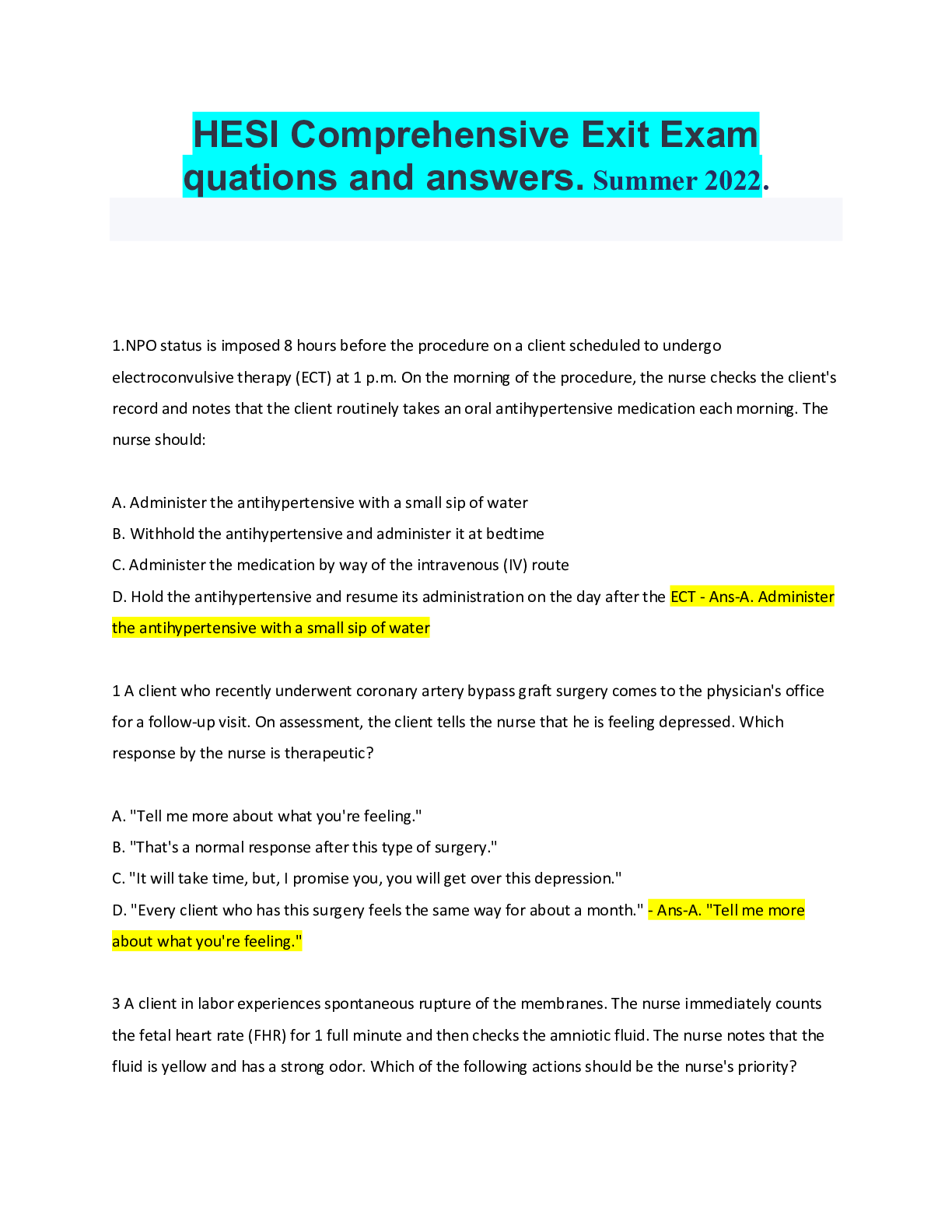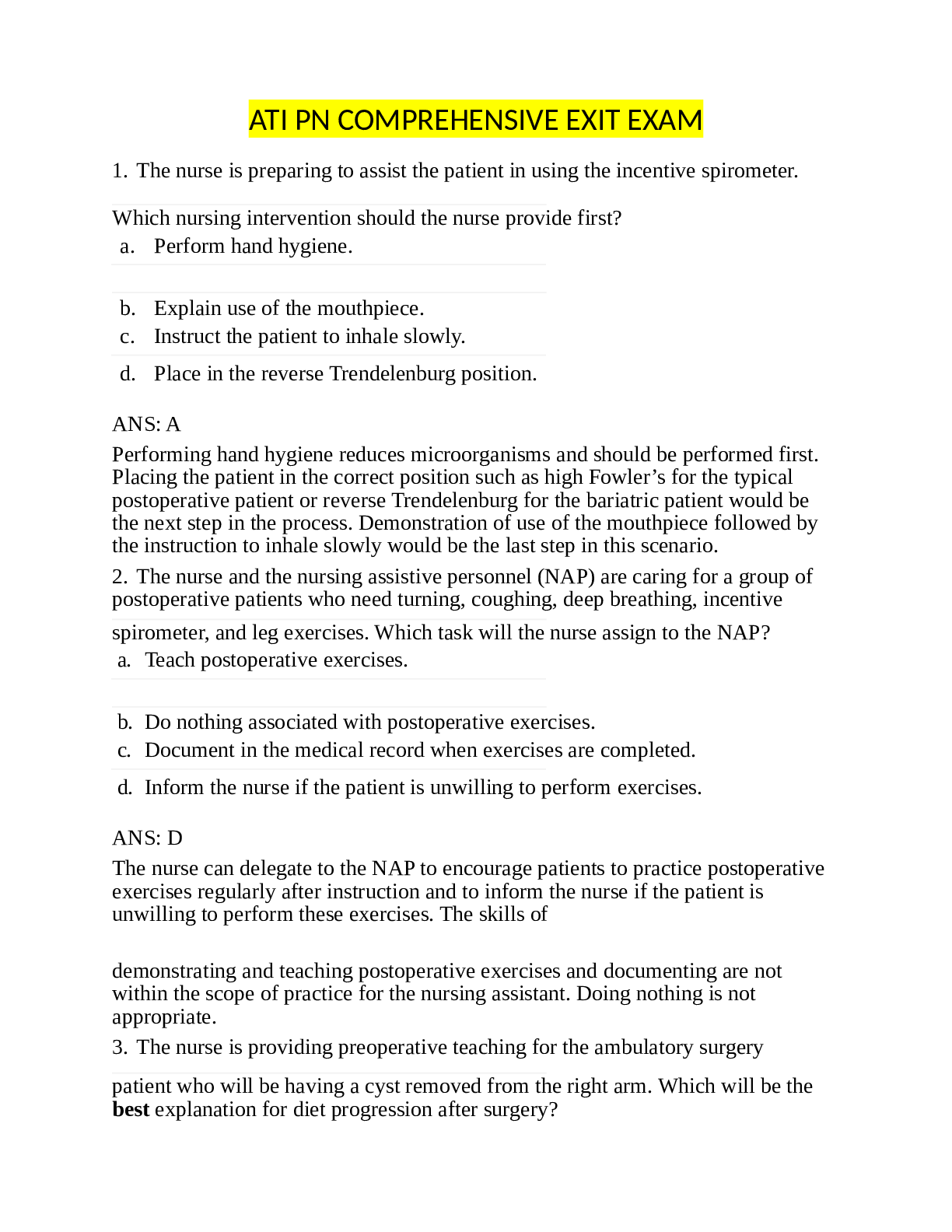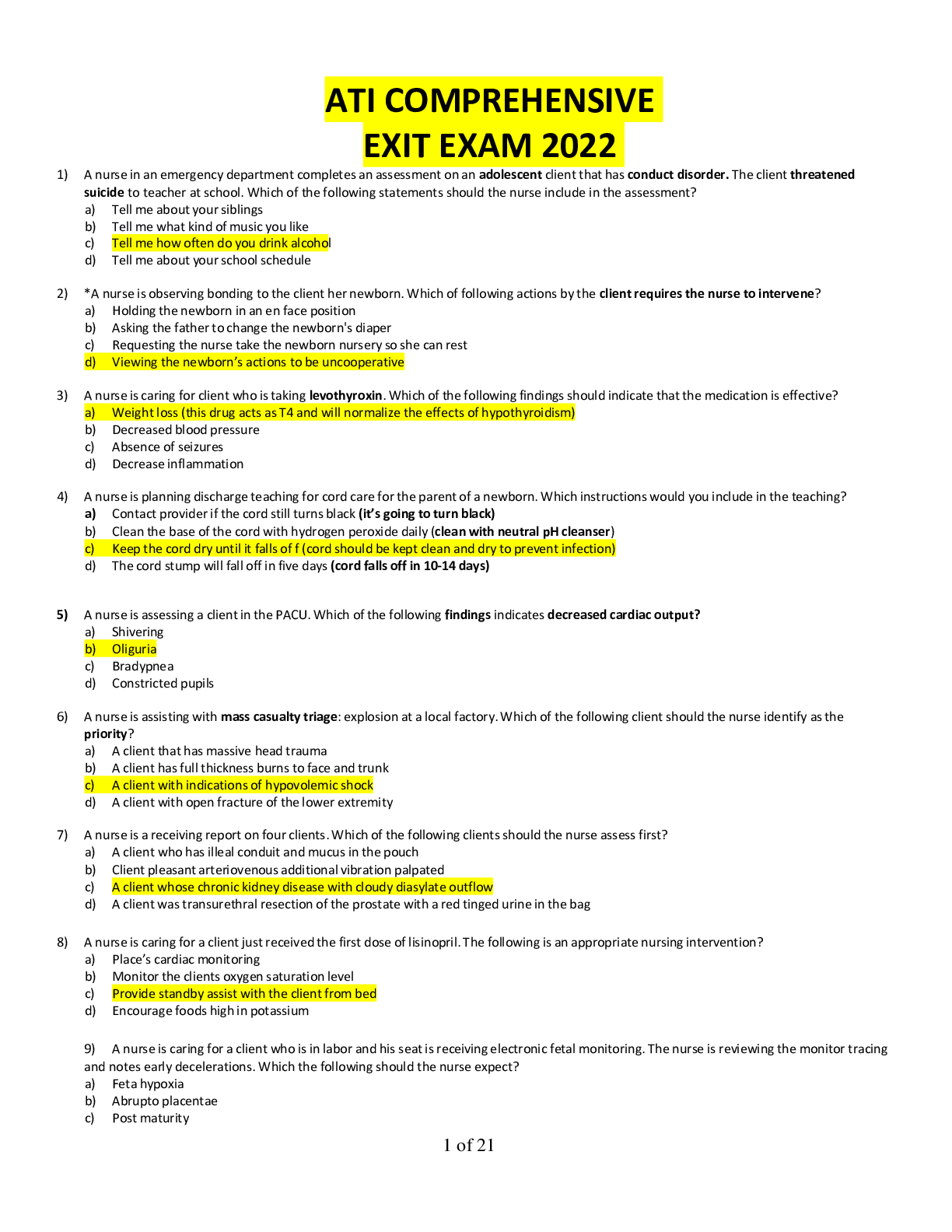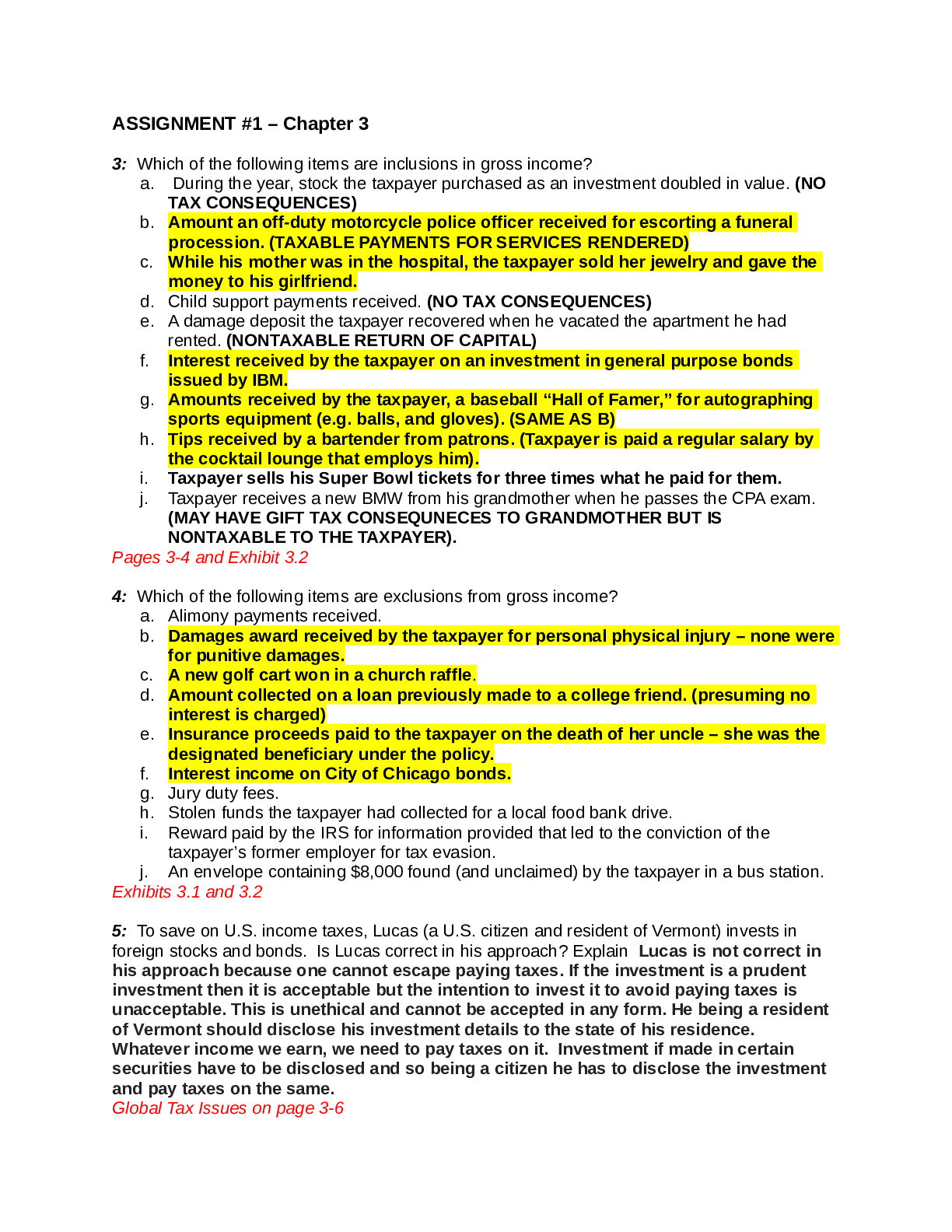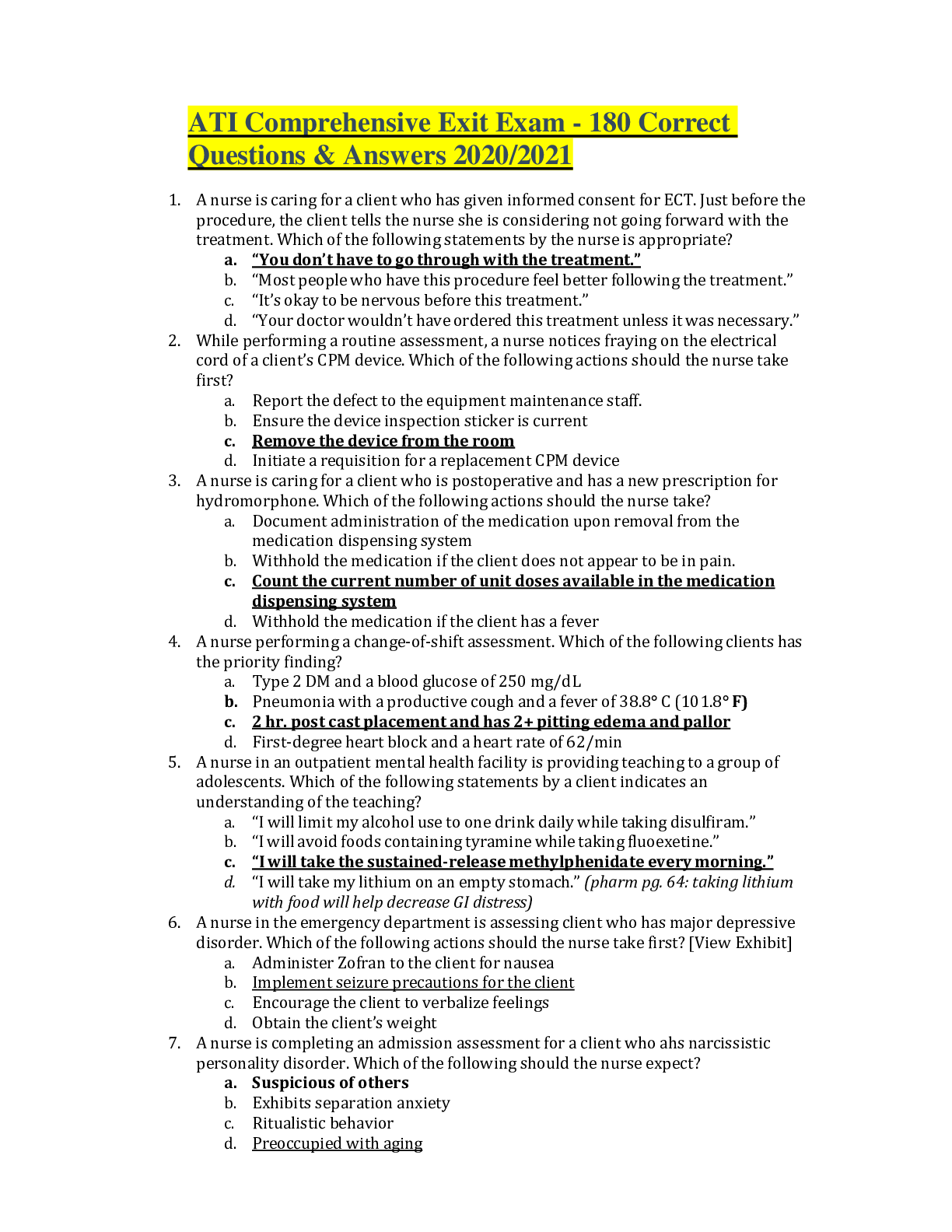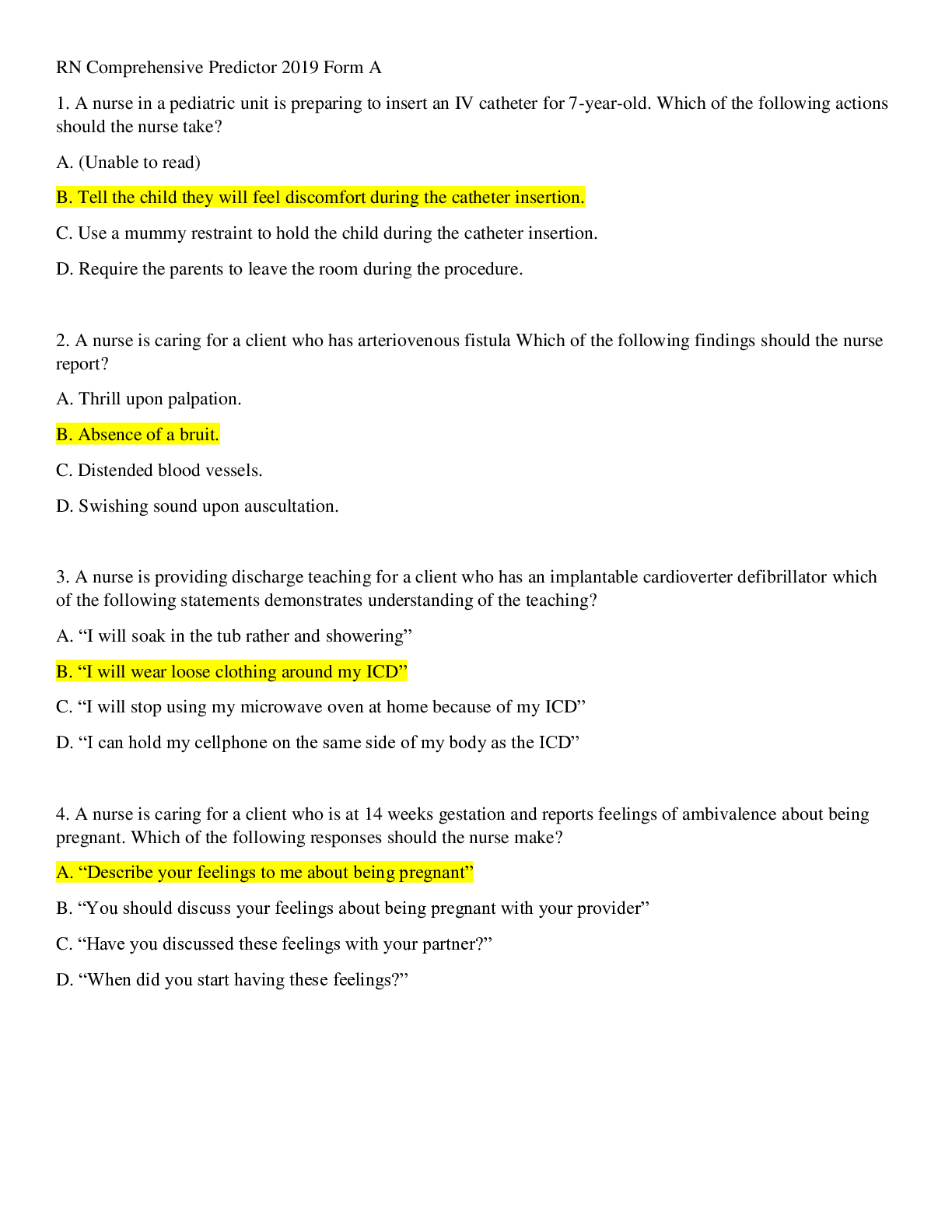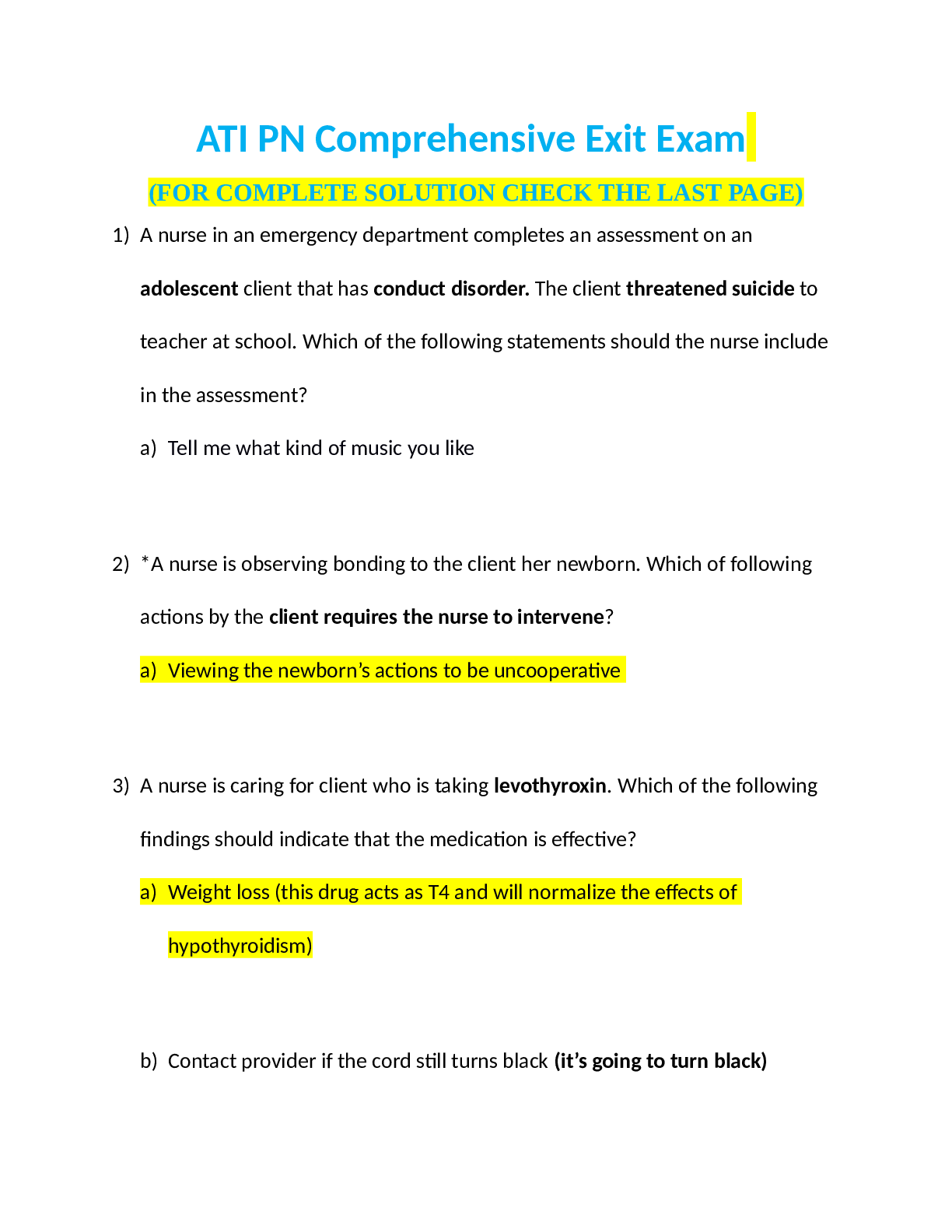*NURSING > QUESTIONS & ANSWERS > NUR3180>ATI RN COMPREHENSIVE EXIT EXAM (2)<questions with verified answers. DOWNLOAD TO SCORE A (All)
NUR3180>ATI RN COMPREHENSIVE EXIT EXAM (2)<questions with verified answers. DOWNLOAD TO SCORE A
Document Content and Description Below
When analyzing an ECG tracing, you notice that the rhythm is highly irregular. The best method to calculate the rate is the Six-second count methodWhile evaluating a 22-year-old female runner who ca... lled 911 because she fell and twisted her ankle, you apply an ECG monitor. Her heart rate is 46, P waves are normal and upright, the PR interval is 0.16 second, and the QRS complex looks normal. There is a QRS complex following each P wave. The patient's ECG tracing reflects: Sinus bradycardia While evaluating a 22-year-old female runner who called 911 because she fell and twisted her ankle, you apply an ECG monitor. Her heart rate is 46, P waves are normal and upright, the PR interval is 0.16 second, and the QRS complex looks normal. There is a QRS complex following each P wave. Treatment for this patient's heart rate should include: No treatment at this time An undesirable side effect of atropine is: Increased myocardial oxygen demand Isoproterenol raises the heart rate by functioning as a: Beta agonist ECG analysis reveals that each P wave in the tracing has a different shape. The heart rate is 80 beats per minute. This is called: Wandering pacemaker Which of the following may cause sinus bradycardia? Intrinsic sinus node disease Atropine works by inhibiting: Parasympathetic response An ECG strip shows a regular rhythm with a QRS complex of 0.08, a rate of 145, a PR interval of 0.12, and one upright P wave before each QRS complex. You suspect that this rhythm is: Sinus tachycardia You are called to evaluate a 64-year-old woman who complains of palpitations, weakness, and dizziness. Her heart rate is 160 beats per minute, her blood pressure is 118/ 80 and her respiratory rate is 28. The ECG tracing shows narrow QRS complexes and no identifiable P waves. This rhythm is most likely: SVTYou are called to evaluate a 64-year-old woman who complains of palpitations, weakness, and dizziness. Her heart rate is 160 beats per minute, her blood pressure is 118/ 80 and her respiratory rate is 28. The ECG tracing shows narrow QRS complexes and no identifiable P waves. The first recommended treatment for this patient is: Valsalva maneuver Which of the followinYou are called to evaluate a 64-year-old woman who complains of palpitations, weakness, and dizziness. Her heart rate is 160 beats per minute, her blood pressure is 118/ 80 and her respiratory rate is 28. The ECG tracing shows narrow QRS complexes and no identifiable P waves. Which of the following drugs is a class I (recommended) drug for this patient? Adenosine You are called to evaluate a 64-year-old woman who complains of palpitations, weakness, and dizziness. Her heart rate is 160 beats per minute, her blood pressure is 118/ 80 and her respiratory rate is 28. The ECG tracing shows narrow QRS complexes and no identifiable P waves. The patient begins to develop chest pain, and her blood pressure drops to 100/60. The treatment of choice for this patient is now: Synchronous cardioversion first synchronous cardioversion for patients in PSVT should be at: 50 J You see an irregular rhythm on the monitor with a rate of 66 to 80, a normal PR interval, and a P wave for every QRS. The rate speeds up and slows down with the patient's respiratory rate. You suspect that this rhythm is: Sinus dysrhythmia Vagal maneuvers for SVT include: Facial immersion in ice water Atrial flutter is almost always caused by: Rapid reentry You are treating a 70-year-old male patient with atrial fibrillation. The patient's ventricular heart rate is 180 beats per minute, the blood pressure is 90/60, and the patient complains of chest pain. The hallmark of atrial fibrillation is: An irregularly irregular rhythmYou are treating a 70-year-old male patient with atrial fibrillation. The patient's ventricular heart rate is 180 beats per minute, the blood pressure is 90/60, and the patient complains of chest pain. You have determined that your atrial fibrillation patient is unstable and requires electrical therapy. You will perform _____ countershock with _____ joules Synchronized; 100 You are treating a 70-year-old male patient with atrial fibrillation. The patient's ventricular heart rate is 180 beats per minute, the blood pressure is 90/60, and the patient complains of chest pain. If this patient's atrial fibrillation has been present for more than 48 hours, conversion of this patient's rhythm may lead to: Release of emboli Junctional escape rhythms: Occur when the SA node fails to fire An ECG strip shows a rhythm with a rate of 45, a QRS of 0.08, and a P wave that appears after the QRS. You suspect that this dysrhythmia is most likely: Junctional The intrinsic rate for a ventricular pacemaker is _____ beats per minute. 20 to 40 Your patient has a regular bradycardic rhythm with a rate of 40, no P waves, and a QRS greater than 0.12. This is: Ventricular escape rhythm Absolute bradycardia means that: The heart rate is less than 60 beats per minute Which of the following may be a lethal treatment for a patient with a ventricular escape rhythm? Lidocaine You are treating a patient who is complaining that his heart is "skipping beats." On ECG evaluation, you see frequent PVCs that are occurring in groups. The patient's blood pressure is 100 systolic. Treatment for this patient: Should include oxygen and lidocaine The treatment of choice for a symptomatic ventricular escape rhythm is: Pacin [Show More]
Last updated: 1 year ago
Preview 1 out of 239 pages

Reviews( 0 )
Document information
Connected school, study & course
About the document
Uploaded On
Apr 16, 2021
Number of pages
239
Written in
Additional information
This document has been written for:
Uploaded
Apr 16, 2021
Downloads
0
Views
28












.png)

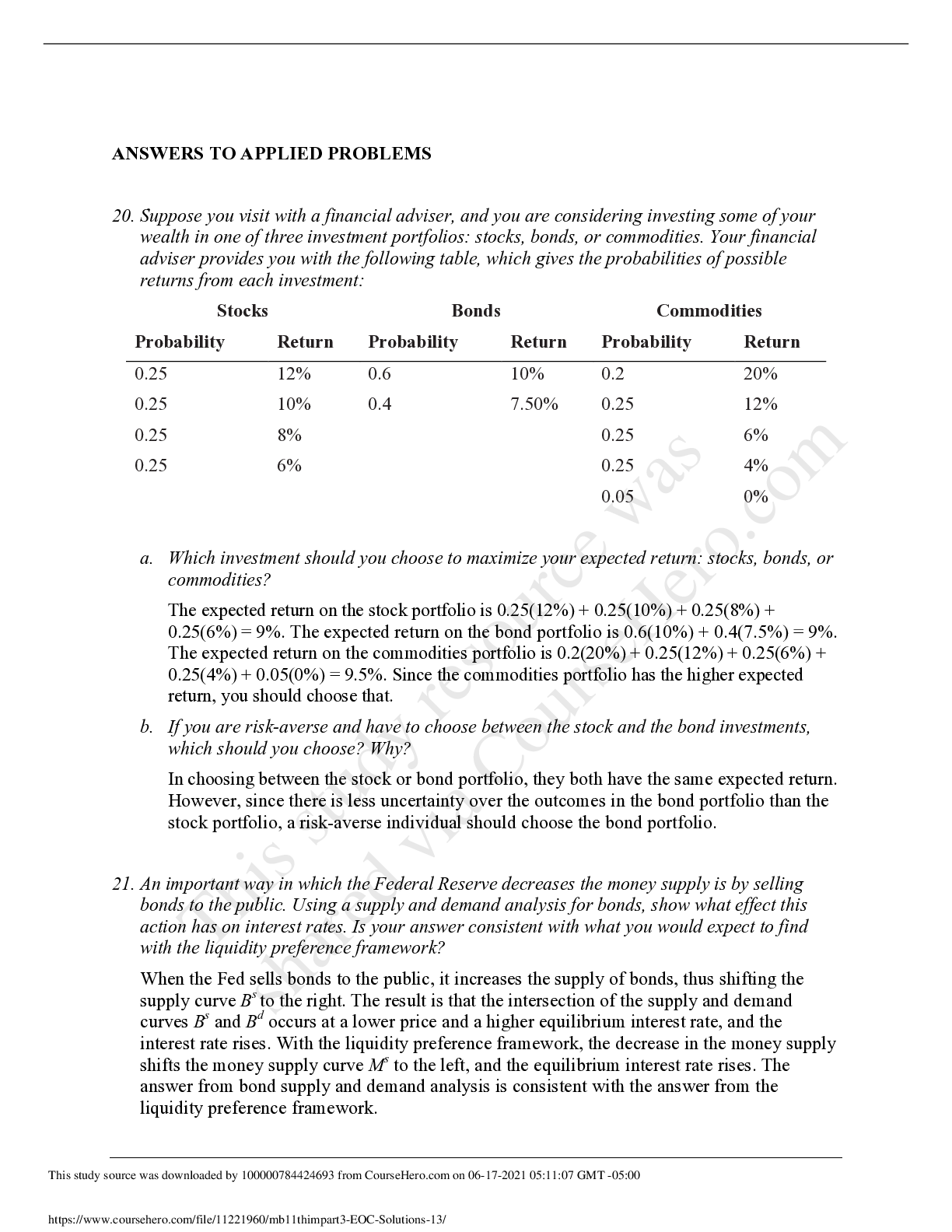

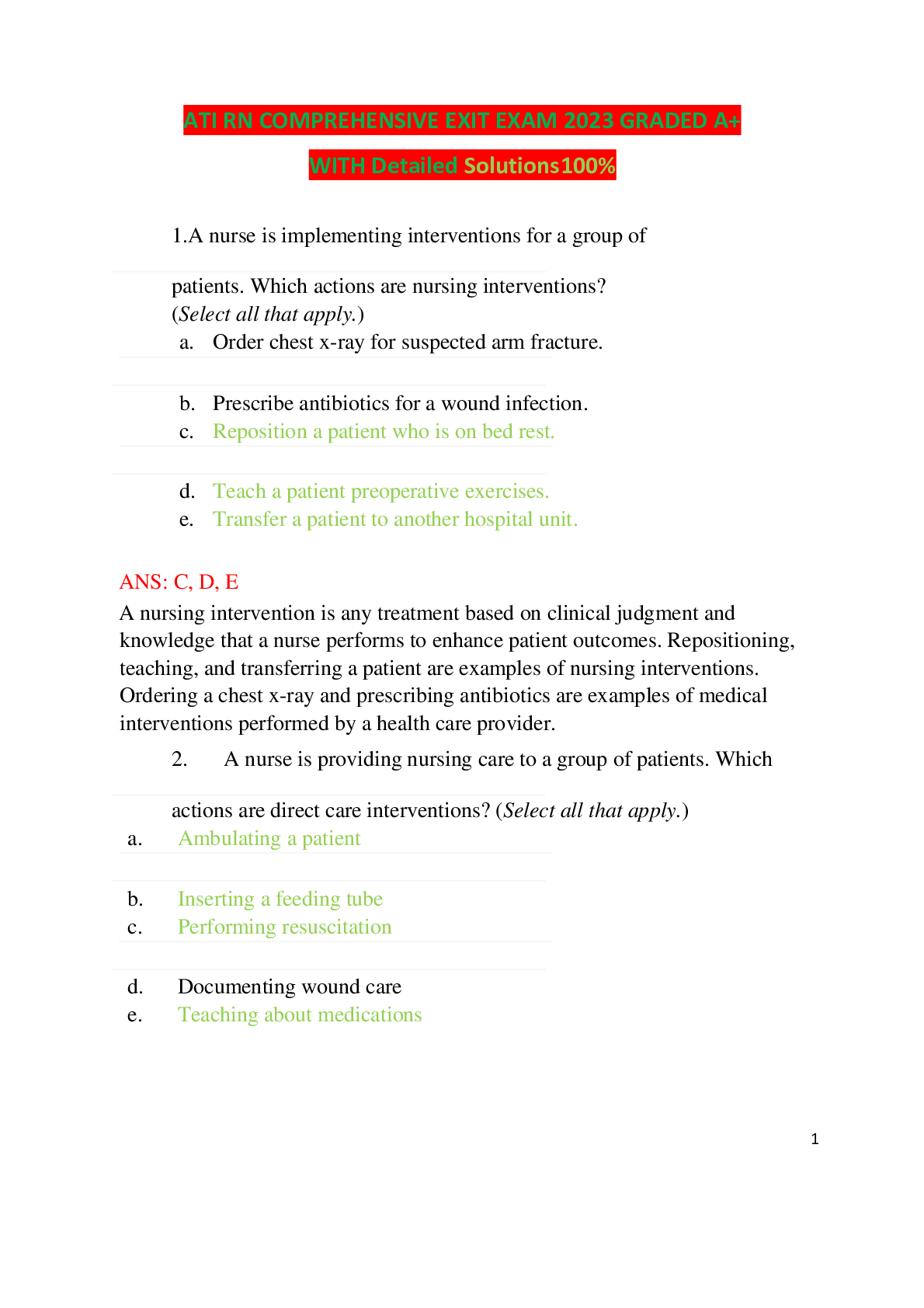
.png)

